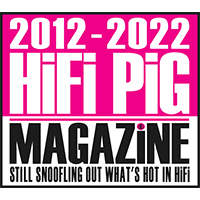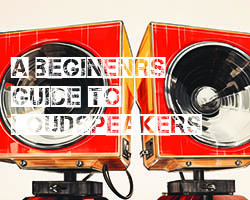SILENT ANGEL MUNICH M1 AND FORESTER F1 REVIEW
Chris Baillie checks out the Silent Angel Munich M1 music streamer and Forester F1 linear power supply for HiFi Pig.

Silent Angel Munich M1 music streamer and Forester F1 linear power supply shown together.
I admit I was surprised when Stuart asked me to review this product. Not because he asked ME but, despite being an owner of the Silent Angel Bonn N8 network switch for the last 18 months, I had not looked into the brand too much and had no idea they offered a range of streaming products and a server. As a subsidiary of Thunder Data, which provide network and server solutions for the industrial market, Silent Angel offers the same for audiophiles & music lovers. Their website reveals the impressive resume of Dr Eric Jian Huang, their C.E.O. I nodded in agreement when I read their (presumably original) philosophy;
‘The fact that digital music system carries more data than CD, but the sound quality cannot compete with it, we want to unleash the power of digital music system. It should be better than CD and beyond’.
I think this very much echoes how far we have come since the birth of music streaming.
Silent Angel design and manufacture a great deal of the internal components used in their products in-house and have gone to the trouble of producing their own App for both IOS and Android devices, going by the name of VitOS Orbiter. The Munich is available in two versions, the M1T streaming transport only model, priced at £699, and the M1 streamer with DAC tested here at £999.
The Forester is a product I was already aware of and had considered purchasing as an upgrade for my Bonn N8. It retails at £429. I had not appreciated that it could simultaneously supply clean power to two products and had felt it a little expensive. Owners of both the Bonn N8 and Munich streamer can power both products via the Forester, potentially ridding their systems of two wall-warts, making the Forester F1 better value than I first appreciated.
BUILD QUALITY AND FEATURES
Both Munich and Forester follow a similar form to the Bonn N8 to enable stacking. At just 15.5cm wide, both products placed side-by-side take considerably less space than a full-width HiFi component. I was quite taken by the understated appearance of the products, being of high-quality CNC aluminium and bearing a smartly etched brand logo on each A single 6.3mm headphone socket differentiates the Munich M1 from its M1T sibling.

Around the back of the M1.
The Forester F1 has a 3 pin IEC socket, a large rocker power switch and two DC outputs. Things are a bit busier at the back of the Munich M1. In addition to the DC input, there is a LAN input, rocker power switch, inputs for up to 3 USB flash memory sticks or USB hard drives, outputs for both RCA analogue, digital over USB, coax, plus notably AES and I2S. There are also sockets for both M-IO and M-link, for peripheral access. It is worth noting that when I attempted to connect my Seagate USB powered drive, I was greeted by a message stating that there was not enough power for such a device and that only mains powered HDDs are supported. Totally understandable, but I feel worth pointing out in case you need to factor this into your own evaluation.

A look inside the M1 from Silent Angel.
THE VitOS ORBITER APP
I feel this deserves a special mention as I was particularly impressed by it. I downloaded the app for my Samsung S21 phone and Apple iPad and it ran flawlessly on both devices. A first for me was compatibility with Amazon Music HD, which I set up a trial for and it worked as perfectly as the rest of the services. Also available are Qobuz, Tidal, a beta version of the excellent HIRESAUDIO service, Internet Radio, Spotify Connect and Apple Airplay 2, the latter two my son tested for me and found they worked as expected. I do have to qualify that the Munich does not speak MQA and cannot (itself) unfold this flavour of hi-res files. However, it does work with Roon, users of which would benefit from the first unfold, allowing unpacking of MQA files up to 24/96. I don’t currently have a Tidal account but have previously tested both Roon and Tidal whilst reviewing other products, and the unpacking of MQA files worked.
The VitOS Orbiter app controls volume output to headphones and allows users to toggle between the internal DAC output to a connected USB DAC. I did test the unit with a USB Flash drive, which worked flawlessly. Connecting to my network attached Melco NA1/2 server was somewhat different to other streamers I have used, in that I had to activate SMB file sharing for it to see the folders. I generally keep this function defeated for various reasons, but not a big deal I guess. Additionally, there is a setting to enable or disable DLNA compatibility. When activated I could send files to the Munich M1 from other apps, such as Bubble UPnP and MConnect.

The board inside the Silent Angel Forester.
CABLE FLAVOURING
Also included in the package from Silent Angel was an assortment of ‘DC’ cables, known as Bastei. I have to admit that reading the manufacturer’s description of each of the cables’ sonic properties initially brought a smile to my face, possibly a translation thing. As we will see later, each did bring its own effect to the sonic balance of the streaming system. These range in price from £59 for a 20cm all copper – Light Orange cable, to £479 for the all silver Snowy White cable in 150cm length! The 20cm Snowy White costs a more reasonable £119. There are two hybrid silver/copper cables are offered at £89, Black Tiramisu and Zebra Plaid. With the Black Tiramisu, the positive terminal is connected to the silver cable, the negative terminal to the copper; the cable connections are reversed with the Zebra Plaid.
SOUND QUALITY
For this review, I used the components in my main system and a headphone-based ‘desktop’ set up in my office.
The main system consists of a Moon 780D DAC, Moon 600i amp, Totem Forest Signature Speakers, all fed via Melco S100 switch. Files were streamed via both my Melco NA1/2 and Qobuz
I use both my Hifi Man Sundara headphones and Cardas A8 IEMs in my office set-up. Using this set-up, I listened to both the internal DAC, Chord Mojo2 and Chord Hugo 2. Unfortunately, my Silent Angel Bonn N8 switch is out on loan to a friend, so I had to make do with a direct connection to the router.
I began listening to the Munich M1 via the supplied wall-wart SMPSU (Switch Mode Power Supply Unit). A 24/44.1 stream of Bonobo’s latest album, Fragments gave a pleasing, well-balanced presentation, with a good sense of timing and strong, punchy bass, especially via the Cardas A8s. Swapping over to the Chord Mojo 2 revealed more detail and sense of life in the recording, but the music was still very enjoyable via the Munich’s internal DAC. Using the VitOS Orbiter app, I compared the relative sonic merits of both Qobuz and Amazon HD, this being the first time I tried it. I found direct comparison generally went in Qobuz’s favour, perhaps not surprising as many recordings on Amazon HD were only available at lower resolutions than with Qobuz. It is good that the VitOS App gives users a choice, though, and Amazon HD can work out cheaper than Qobuz.
The addition of the Forester F1 linear power supply (LPSU) brought an immediate and significant improvement to the performance of the Munich M1. Tonal colours were fleshed out with each instrument possessing more depth and timbre. The timing benefitted considerably, which meant that the slower, more acoustic moments in Jethro Tull’s latest album, The Zealot Gene, streamed via Qobuz at 24/48, were now holding my attention and enabling me to appreciate just what a great piece of work Ian Anderson has created in the twilight of his career. With the Forester F1 supplying the power, I was able to enjoy how the mandolin to the left of the soundstage juxtaposes the acoustic guitar with appreciable snap and drive. There was no sense of harshness here, a palpable sense of acoustic helping deliver a reasonably believable soundstage.
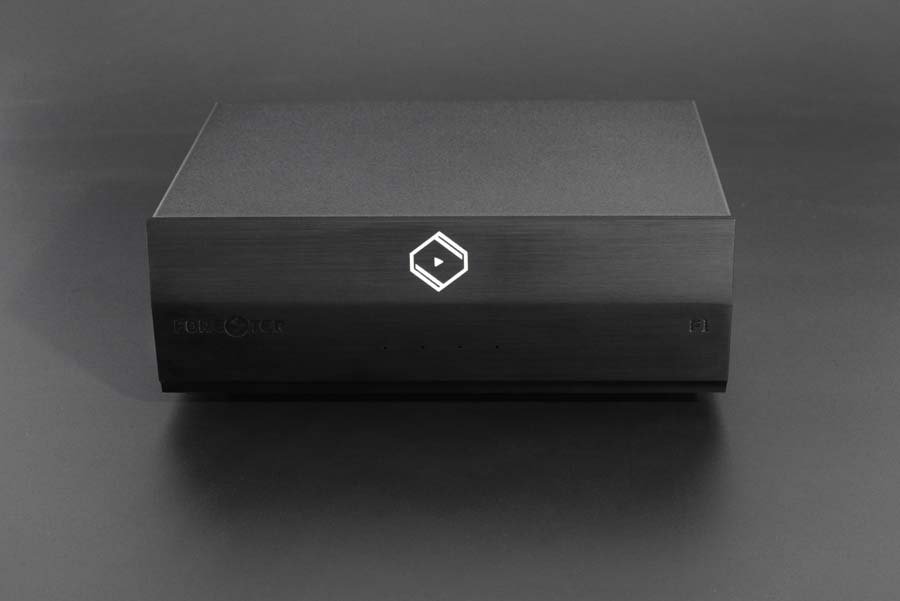
The Forester has the same look and casing as the Munich.
Bypassing the Munich M1’s internal DAC to feed Chord’s Mojo 2, brought further increases to the sense of snap and drive; the bass guitar now possessed a sense of bounce, as well as depth and detail. The top-end was further extended, although possibly at the expense of smoothness and integration. Until this point, I had been using Chord’s Poly to feed Mojo 2. The Silent Angel combo revealed improvements in both timing and a lowering of the noise floor. I suspect this is due to the wired connection as the Chord Poly is Wifi only. Substituting Mojo 2 for Hugo 2, brought the expected improvements over both the Silent Angel’s internal DAC and Mojo 2, the bass sounding fuller and more solid. With that change, I also now enjoyed a far more natural sense of acoustic. What was clearly a low noise signal from the Silent Angel source, allowing Hugo 2 to replace the slight lack of top-end resolution of Mojo 2, with a natural rendering of percussion instruments. Ian Anderson’s signature flute playing was now sounding glorious and dancing around at the front of the improved multi-layered soundstage.
Having copied The Zealot Gene CD to a WAV file, I loaded it onto both a USB stick and my Melco server for comparison between both sources and, just for fun, compared this with the Hi-Res Qobuz stream. By now I had moved the Silent Angel pairing to the main system rack, and I could connect to the Melco S100 network switch. Starting with the Qobuz feed and still feeding Hugo 2, the noise floor dropped significantly, revealing a greater sense of dynamics and drama, with the sense of acoustic and reverb effects now even more palpable. Playing the track via USB was simple and almost instant. The CD rip losing out to the Hi-Res version in terms of soundstage depth and sense of acoustic, although, perhaps, sounding a little more focused. The same track fed by the Melco, via an Audioquest Coffee USB cable did sound a little more natural and expansive than via the USB stick almost, but not quite, matching the sense of acoustic and a general sense of spaciousness of the Qobuz Hi-Res feed.
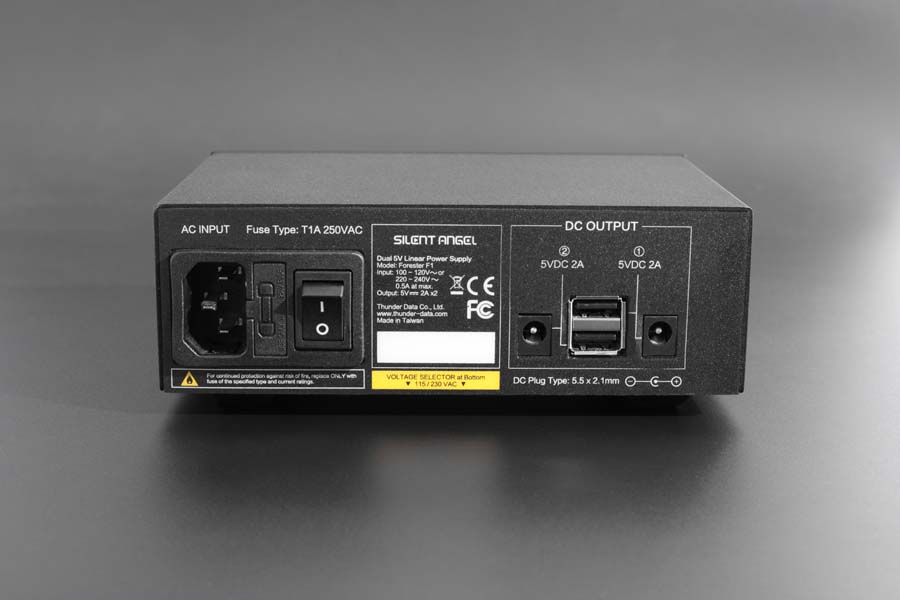
And around the back of the Forester PSU.
Finally, I hooked up the Silent Angel streamer to my main system. My Moon 780D is a high-quality DAC, which has its own built-in streamer. With this in mind, I did briefly connect the analogue outputs of the Munich M1 to my amplifier and experienced the expected drop in performance. However, there were no nasty edges, and I could still enjoy the music it fed my Moon 600i amplifier. The sins being more of omission, particularly at the frequency extremes and sounding a little constrained. With the Munich F1 feeding the Moon 780D over USB, the music sounded vibrant, detailed and dynamic, although a little more shut-in and between the speakers than via the Moon 780D’s MiND 2 streaming board. Using the Melco NA1/2 to stream Qobuz over USB connection to the Moon DAC, did give results closer to the 780D’s internal streaming board, which suggests that the Munich M1 isn’t quite up to the standards of the, admittedly much more expensive, Melco NA1/2.
With the Munich M1 now back in my office, it was time to indulge in a bit of cable rolling, courtesy of the four different flavours of Bastei DC cables, connecting the Forester F1 to the Munich M1. I must confess that swapping these cables brought far more significant changes than expected. The Snowy White cable brought a night and day improvement over the basic cable, supplied with the Forester F1. The Light Orange cable also brought a more defined sound over the generic cable. I enjoyed listening to the Zebra Plaid cable far more and it delivered the music with a firmer foundation than the Black Tiramisu cable, which I found a little lean, at least in my set-up. The Snowy White cable was the best of the bunch, giving instruments more body yet delivering a more open top end. This discovery caused me frustration as I thought I was close to finishing the review and then had to put the Munich M1 then back in my main system. Sure enough, with the Snowy White between the Forrester F1 and Munich M1 feeding my Moon 780D, the results were much closer to the Melco NA1/2, although the Melco still held a slight edge, sounding a little more spacious and relaxed. The Moon 780D’s internal MiND2 did still sound far more natural and expansive than both, but being housed in the DAC unit does of course avoid potential losses via a USB connection. I found the Munich M1 feeding the Chord Hugo 2 gave a slightly more expanded soundstage, with greater depth compared to the same DAC fed with the Chord 2Go. I suspect due to the quality of the power supply, courtesy of the Forester F1, in comparison to the small battery in the Chord streamer.
CONCLUSION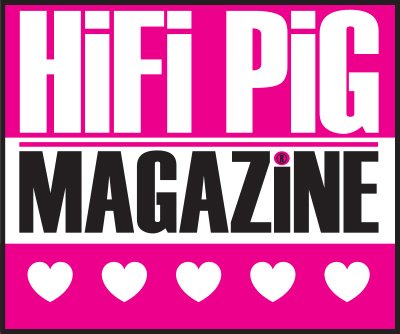
I shall miss the Munich M1 when it goes. It has been a great listening companion, especially in my office set-up.
Whilst not quite scaling the heights of my Chord Hugo 2/2Go, the Munich M1, powered by the Forester F1 via the Snowy White cable, proved enjoyable enough for me not to miss the more expensive option unless I made a conscious effort to, which is quite a compliment.
The VitOS App proved reliable and was simple to use. Amazon HD compatibility is rare and will please many. For those with sizeable file-based music collections, something like the Melco N100 for a few hundred pounds more, or perhaps a model from the Innuos stable might deliver even more performance without needing an external NAS drive. For users who mainly stream from cloud-based providers, but appreciate the flexibility of adding a digital library via thumb drives or an external HDD the Munich M1 is a great solution, especially if a headphone output is desired. For music lovers who already have a DAC they are happy with, the transport only Munich M1T offers more convenience and better sonic performance than a computer.
The units are solidly built, look great and take up relatively little desk or rack space.
What’s not to like?
We Loved:
Refined sound with a good sense of timing
Good quality headphone stage
Flexible range of digital inputs
Great looks and small form factor
Well sorted VitOS Orbiter app
Compatible with a wide range of streaming services
Tweak factor via Bastei cables
Roon compatibility
Value For Money:
I feel the Munich M1 is very competitive at its price point. For those who don’t need the headphone stage and internal DAC, the M1 T transport-only version is £300 less. At first acquaintance, the Forester F1 power supply does seem expensive, until you consider it can also power the Bonn N8 switch simultaneously with a Munich streamer.
We Didn’t Love So Much:
Lack of MQA compatibility for Tidal Lovers, although Roon can help with this
VitOS App did not integrate with my Melco library quite as well as other apps I have used. To be honest, you probably would not buy this if you already owned a Melco, although some may do so for an additional set-up
Only compatible with mains powered external HDD or SSD drives
Nothing else considering the price point!
Prices:
Munich M1 Streamer with DAC – £999
Munich M1T Streaming Transport only – £699
Forester F1 PSU – £429
Bastei cables range from £59, up to £119 for the 20cm lengths supplied.
Elevator Pitch Review: Full-bodied performance with an engaging sense of timing. The VitOS Orbiter app is great, and Roon users are also catered for. The unit has flexible inputs and outputs a quality headphone stage and takes up very little space.

Chris Baillie
